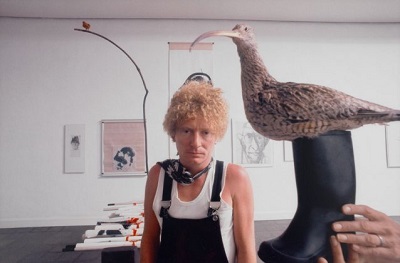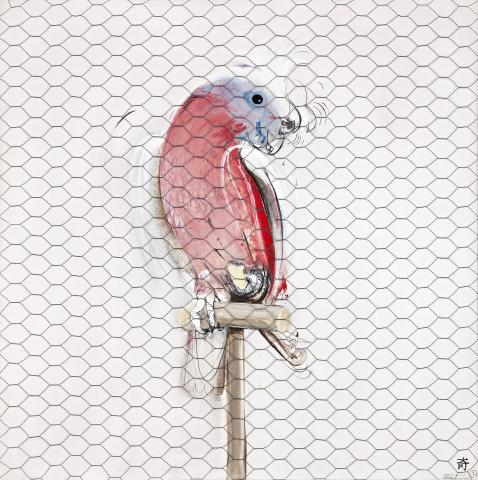GALAH, 1988
BRETT WHITELEY
oil, collage and wire on canvas
121.0 x 121.0 cm
signed lower right with artist's studio stamp
inscribed lower right: [Chinese character, translation in English:] / 1 strange, uncanny, occult, / rare / 2 wonderful / 3 to feel strange about; to wonder
signed and inscribed with title verso: Brett Whiteley / ‘Galah’ / oil on canvas + chicken wire
Private collection, London, acquired directly from the artist in 1988
Deutscher ~ Menzies, Melbourne, 21 September 2005, lot 17
Gould collection, Melbourne
Brett Whiteley, Birds 1988: recent paintings, drawings, sculpture, and one screen print, The Artist’s Studio, Sydney, 5 – 19 July 1988, cat. 4 (as ‘Gullah’)
The Director’s Choice 2010, Gould Galleries, Melbourne, 6 May – 5 June 2010, cat. 1 (illus. cover of exhibition catalogue)
The Director’s Choice 2015, Celebrating 35 Years, Gould Galleries, Melbourne, 1 May – 13 June 2015, cat. 20 (illus. in exhibition catalogue)
6. Lewis Morely, Brett Whitely 1974.jpeg

‘People ask me ‘why paint birds?’ and I look at them dumbfounded! I’ve got no answer, except that they are the most beautiful creatures…’1
Throughout his rich and varied oeuvre, birds have always held special appeal for Whiteley – both in the aesthetics of their formal appearance and metaphorically, as symbols of peace, freedom and salvation. Diametrically opposed to his darker, more tortured musings in their absence of angst, his depictions of birds – whether as individual studies or components of a larger composition – offered rather the promise of tranquility and happiness, ‘…an art based on the idea of extraordinary escapism, a world external from the quagmire…’2 It is perhaps not surprising therefore, that Whiteley would embrace the sublime beauty and serenity of the animal kingdom for respite during the most psychologically grueling challenges of his art and life – for example, the spirited London Zoo paintings painted at the same time as his unflinching confrontation of depraved evil in the Christie series (‘beast’ astutely juxtaposed alongside ‘bestial’). Or the idyllic paradise of Fiji, resplendent with sensuous fruit doves and hummingbirds, in which Whiteley delighted following the turmoil and violence of New York, epitomised by his magnum opus The American Dream, 1969. Indeed, as Sandra McGrath elucidates, Whiteley’s enduring spiritual connection with the natural world may be considered an integral part of the complex Rimbaudian duality punctuating his practice; ‘…in truth he was living out one of his constant themes – good and evil, optimism and pessimism, New York and Fiji, Christie and the London Zoo series… all meshed into one overall psychological and pictorial design, one lifelong attempt to reconcile extremes, one eternal battle to identify the truth that E.M. Forster recognised as being accessible only by experiencing opposites.’3
That Whiteley chose to dedicate an entire solo exhibition to the subject of birds eloquently attests to the privileged role accorded these feathered creatures in his art. Held at his studio in Surry Hills, Sydney in July 1988, the landmark show featured major works encompassing all media, from his highly acclaimed bronze ‘Bird Sculptures’ of 1983 – 88 and unforgettable Boot Owl, 1985 (imaginatively created from an old boot, ping pong balls, steel and paint), to monumental canvases such as the celebrated Frangipani and Hummingbird, 1988; The Sunrise: Japanese Good Morning!, 1988; and present Galah, 1988 – all executed during the same year. Never one to be constrained by the physicality of a canvas or board, Whiteley often added collaged elements or objets trouves to extend the composition – and certainly Galah is no exception, with its overlay of chicken wire extending to the edge of the canvas, creating a tension between ‘real’ and ‘imagined’ that is only heightened by the ambiguity of the subject here. Betraying strong affinities with both Whiteley’s own earlier London Zoo paintings of 1965 and the ‘caged figures’ of his artistic mentor Francis Bacon, Galah is similarly imbued with an unmistakable feeling of disquiet. Multiple beaks, gestural lines and Whiteley’s iconic arrows all serve to imply and exaggerate the bird’s motion, yet its piercing gaze remains fixed and resolute, posing the enigmatic question – who is actually caged, the animal or the viewer?
Quite poignantly perhaps, curator and art historian Barry Pearce has hailed Whiteley ‘Australia’s most sublime painter of birds’, noting that ‘…they have appeared, often larger than life, in many of his most important paintings’ and even suggesting that ‘it is not too fanciful to think of Whiteley’s bird paintings as self-portraits.’4 Similarly, art critic Alan McCulloch considered Whiteley’s paintings of the bird and animal kingdoms among his best, ‘perhaps because in these relatively uncontaminated domains he is motivated more by love than despair’.5 Embodying the tremendous sense of freedom and profound curiosity provoked in the artist by the natural world, Whiteley’s bird paintings are indeed, undoubtedly, among the most touchingly beautiful yet playful of his prodigious career. As poet Robert Gray perceptively reflected around the time of the present work’s execution, ‘…in Whiteley’s bird paintings is embodied his finest feeling. They are to me his best work. I like in the bird-shapes that clarity; that classical haptic shapeliness; that calm – those clear perfect lines of a Chinese vase. The breasts of his birds swell with the most attractive emotion in his work: it is bold, vulnerable and tender’.6
1. Whiteley cited in Brett Whiteley: Animals and Birds, exhibition catalogue, The Brett Whiteley Studio, Sydney, 2002
2. McGrath, S., Brett Whiteley, Bay Books, Sydney 1979, p. 94
3. Ibid.
4. Pearce, B., Australian Artists, Australian Birds, Harper Collins, Sydney, 1989, p. 144
5. McCulloch, A., ‘Letter from Australia’, Art International, Lugano, October, 1970, pp. 69 – 70
6. Gray, R., ‘A few takes on Brett Whiteley’, Art and Australia, Sydney, vol. 24, no. 2, 1986, p. 222
VERONICA ANGELATOS
